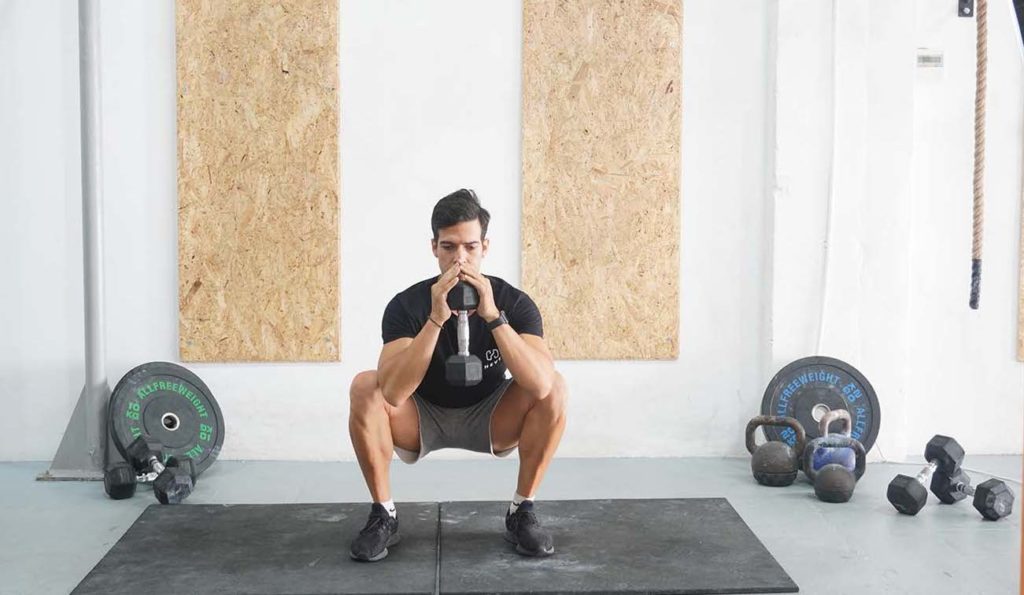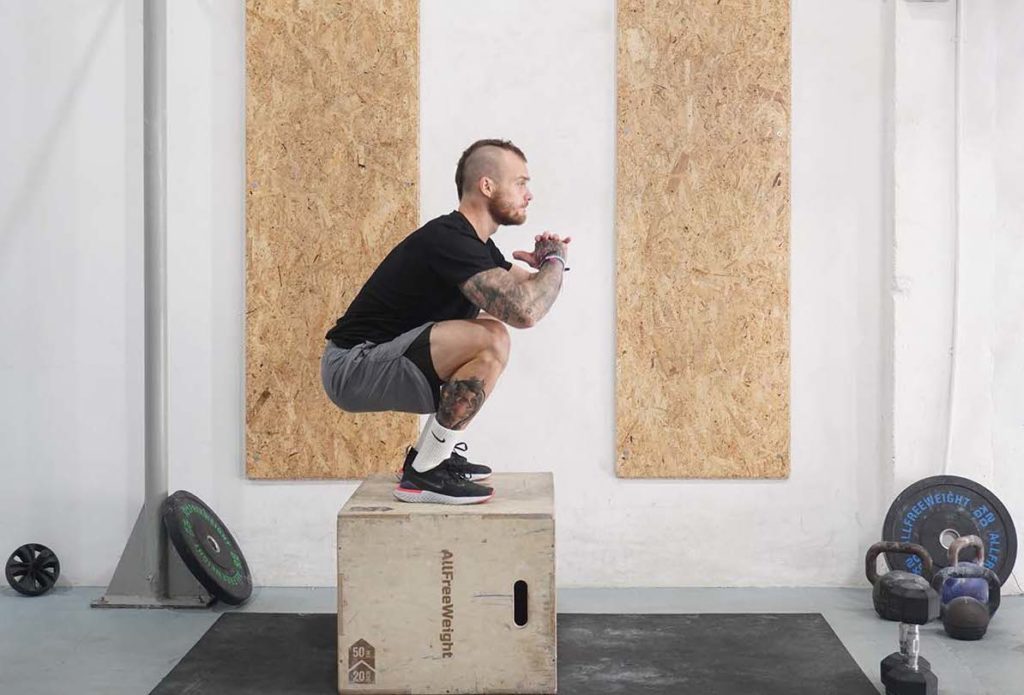The Benefits of Frog Jumps
The frog jump is a simple plyometric exercise that develops lower body musculature, strength, and power. As its name suggests, the movement is about hopping in place like a frog. But, despite the simplicity, the activity is challenging and takes some knowledge to perform effectively.
A notable benefit of frog jumps is that you don’t need equipment. The objective is to assume a wider stance, descend, and jump vertically, accelerating quickly from the bottom.
The second benefit of the frog jump is that you recruit more fast-twitch muscle fibers and develop your power. As a result, you become faster, more explosive, and more athletic. Similarly, the frog jump strengthens your lower body, making everyday activities like walking up a flight of stairs more accessible.
We recommend including the movement near the start or middle of your training sessions. Do multiple sets of just a few reps, performing each as explosively as possible.
Level of Exercise: Beginner/Intermediate
How to do a Frog Jumps
_Plyometrics_small.jpg)
- Stand tall with your feet slightly wider than your hips and toes pointing slightly out.
- Engage your abs and extend your arms with hands in front of your hips or slightly lower.
- Take a breath and descend into a squat, keeping your heels in contact with the floor.
- Descend until your hands brush the floor and keep your knees pointing in the same direction as your toes.
- Immediately push through your heels as powerfully as possible, propelling yourself in the air and exhaling at the top. Keep your arms pointing to the floor.
- Take another breath as you land, descend into the next repetition, and repeat.
What muscles do frog jumps activate?
The primary muscle group that works during the movement is the quadriceps, which make up the front of our thighs and produce knee extension (straightening of the legs) (1). Our quadriceps engage as we start moving down, controlling the descent, and achieve peak activation as we push through the heels for the vertical jump.
Our glutes and hamstrings also contribute during the frog jump. The two muscles make up the posterior of our thighs and buttocks, and their primary function is to extend our hips (drive them forward) (2, 3).
Thanks to the slightly wider foot stance, the adductors (inner thigh muscles) assist the quadriceps during the movement (4). Spreading our feet wider puts the adductors at a mechanical advantage, allowing them to engage more effectively and produce force.
Our midsection musculature also contributes during frog jumps, mainly to provide torso stability. The rectus abdominis, transverse abdominis, obliques, and other muscles in the area flex isometrically.
Tips on Proper form when Performing Frog Jumps
An important tip for safe and effective frog jumps is to engage your midsection before each set and maintain it until you finish. Bring your arms in front of your torso, engage your abs, take a breath, and descend into the first repetition.
Another tip is to land on the balls of your feet and then bring your heels to the floor. Landing on flat feet isn’t ideal because it can place unnecessary stress on your joints and connective tissues, leading to aches.
The third tip for the movement is to experiment with your stance and find the one that works best for you. Ideally, you should have your feet slightly wider than your hips, but slightly narrower or wider can also work.
Our next tip for the frog jump is to keep your torso upright and spine in a healthy, neutral position. Doing so ensures that you reach a good squat depth by brushing the floor with your fingertips before exploding into the vertical jump.
Variations and Modifications of the Frog Jumps
1. Frog Static Squat With Calf Raise
Static squats with a calf raise are a variation you perform without jumping. The movement works well for people who experience aches in their lower body from jumping. Descend and push through your heels to start moving up. But, instead of allowing your feet to lift off the floor, complete by raising only your heels and balancing yourself on the balls of your feet.
2. Forward Frog Jumps
The forward frog jump is the same movement as the one we’ve reviewed. But, instead of jumping up and landing in the same spot, you move forward with each repetition. Doing so offers no specific benefits, but it can be a fun way to do the frog jump.
3. Fast Frog Jumps
Fast frog jumps are a variation where you perform numerous quick repetitions. Instead of jumping as high as you can, the objective is to propel yourself enough so your feet lift a couple of inches off the floor and do as many reps as possible.
Mistakes to Avoid
Leaning Forward too Much
A mistake trainees often make is turning the frog jump into a hip hinge. The error occurs because people focus on touching the floor with their hands by any means necessary. As such, trainees with limited mobility in the hips or ankles resort to leaning forward for their hands to get closer to the floor. Doing so isn’t ideal because it shifts the emphasis to your posterior chain (glutes and hamstrings) and limits quadricep involvement. Avoid the error by maintaining a somewhat upright torso and descending by bending your knees.
Not Breathing
Trainees tend to hold their breath while performing frog jumps, which can hold them back on longer sets. Not breathing prevents your muscles from getting the oxygen they need to keep working, and limits set duration. Fix the mistake by taking a breath as you descend into a squat and exhale as you jump in the air.
Landing on Mid-Foot
The third common error with frog jumps is landing on mid-foot, which places unnecessary stress on your ankles, knees, and hips. Avoid the mistake by landing as lightly as you can by touching the floor with the balls of your feet first and then having the rest of your feet get in contact as you descend into the next squat.
Similar Exercises to the Frog Jumps
Jump Squat
The jump squat is similar to frog jumps because you must descend into a squat and press through your heels to propel yourself. Both activities offer similar benefits and work in identical ways. The primary difference is that your hands are in front of your chest during jump squats, and you move your arms back as you jump in the air. In contrast, frog jumps are about keeping your arms in front of you and stationary as you move up and down.
Goblet Squat

Goblet squats are not a plyometric exercise, but they are similar to the frog jump. Both exercises train the same muscles in the lower body, developing your strength, power, and musculature (5). The primary difference is that goblet squats include an external weight (dumbbell or kettlebell), and you perform repetitions more slowly.
Box Jump

Like jump squats and frog jumps, box jumps are a fantastic plyometric movement that develops power and burns calories. The objective is to stand facing a sturdy object, such as a plyometric box or flat gym bench. Descend to generate some force and jump vertically to land on the box or bench before returning to the floor. Box jumps are beneficial because you always must jump to a specific height, ensuring consistency from rep to rep.

